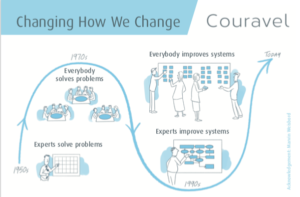Developing listening organisations for the 21st Century
Listening matters
Listening is important. 98% of people agree listening to stakeholder groups is a critical communication competence and 89% say the insights they bring from listening are of strategic importance.1
Listening matters for:
- Responsiveness and survival2
The speed at which industries and markets are changing means we need to be focused on what prospective and current employees consider important. Listening is key to keeping the “corporate finger on the pulse”
- Sensitivity and growth3
Employee expectations are changing. People are increasingly used to co-creating and collaborating in their relationships with organisations and if we do not develop ways to listen well, we will not be able to work the way they want us to
- Trust and empowerment – sustaining change4
Organisations are increasingly transparent. New working models need to enable decision making at lower levels and equip employees with information that helps them act as advocates for employers they trust. Listening is a core component in this mix.
Barriers to Listening
But listening is not something we champion at business school nor in our early years on the corporate ladder. Practical barriers to effective organisational listening include lack of time, discounting unpopular views (“uninformed”), poor empathy, little understanding of others’ perspectives, assumptions, not acting on feedback, or forgetting to link actions to heard concerns or suggestions.
Improving how to listen
To overcome these barriers and improve how we listen here are four suggestions that will make a big difference.
-
Tackle the system
Small organisations are great at listening. As they grow, they lose the knack because managing and organisation gets in the way. Here is a good way to fix this:
- Find two or three performance incidents – both good and bad (e.g. outstanding customer feedback, loss of a valued employee, a service quality breakthrough)
- Get as many in the room or on line with a perspective
- Set a positive learning tone
- Map how the system worked or did not – keep asking why questions to expose root causes and links
- Correlate across the incidents to identify recurring patterns
- Identify insights and explore options for change

Image acknowledgement: Marvin Weisbord; productive Workplaces
2. Listen to emotions
The ubiquitous use of employee surveys has translated employee perceptions into statistics and benchmarks. We have lost sight of the emotions that sit behind the figures, and we have created a dull and uninspiring way of understanding our strengths and weaknesses as employers. To uncover these:
- Create an employee journey from recruitment to induction, through development, promotion, and onto leaving
- For each touchpoint bring together relevant people (new joiners for recruitment and induction, new managers for promotion, etc.); or publish it on line and target key groups to gather feedback on line
- Explore how people felt at these key moments and what made them feel that way
- Identify the positives and negatives and brainstorm what the business could do to change these
- Extend or adapt the approach to cover a day in the life of an employee in a particular role or function
- Map and present the key learnings and model the potential financial benefit of increasing the effectiveness of different stages in the journey

Working on the employee journey at a global engineering business
3. Align with the business
Listening is more powerful when aligned to the business. Leaders listen more when feedback relates not to general perceptions but specific insights relevant to growth, sales, costs, efficiency, quality and other drivers of success.
But what gets people out of bed elsewhere in the business? This might be more about helping customers, saving lives, or providing important services. To improve alignment:
- Organise face to face or virtual discussion groups with different groups to explore:
- Why do you work here?
- What excites and inspires you?
- What makes you proud about what you do?
- What threatens you?
- What worries you about what we do?
- What relationships are important to you?
- Who influences you?
- What feels fair around here; what is not?
- Use the insights from the answers to help leaders understand how they can achieve corporate growth by addressing the things that matter to different groups of employees
- Position messages and help different groups understand each other better, and connect the whole organisation to common goals, even if the emphasis on how the goals are discussed is different with different groups.
4. Create listening groups
To lead and manage these activities on a sustainable basis:
- Choose a mix of people who understand the business from different levels
- Bring them together to create a listening vision for your business
- Provide the ideas above as a start point for improving listening across the business
- Ask them to identify the barriers and key actions to improve listening
- Require them to articulate their role and how to measure their own success at listening
- Provide access to leadership and other groups to improve their impact and reach
- Use the listening groups and their insights as tangible evidence of the organisation’s ability to listen well
Notes
- IABC UK Listening Project; interim research report; May 2019
- Towards the Listening Organisation; Ajith Nair; Human Capital Online; July 2014
- The Missing Link; Watson Helsby; 2018
- The Listening Organisation; NHS Wales; June 2013




